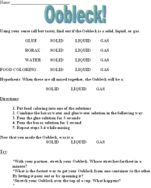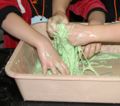Oobleck
| Instant wiki maker | Making handouts | Editing tips |
Biology In Elementary Schools is a Saint Michael's College student project from a course that ran between 2007 and 2010 and fully described in this book chapter. The student-created resources have been preserved here for posterity. Link under 'toolbox' for printer-friendly versions of the exercises. Click on handouts to print full resolution versions. Please see Wikieducator's disclaimer, our safety statement, and the Creative Commons licensing in English and in legalese.
Student worthiness
This idea has been tried and tested by many teachers. We have used it with first and second graders and it was very successful. In addition, we have tried it with cub scout groups and again it was a big hit.
Primary biological content area covered
- Scientific observations
- Senses: touch, sound, smell, sight
- Classification
- States of Matter (solids, liquids, gases)
- Surface Tension
Materials
- Ziploc bags
- Measuring cups
- Tablespoon
- 3/4 cup Elmer's School Glue/Elmer's Glue-All
- 1 cup of water
- 3 tablespoons of borax
- basin for each pair (inexpensive cat litter boxes work well)
- 2 containers or large jars
- Gloves (consider latex allergies)
- Hood or well ventilated area for mixing the borax
- Spoons for mixing solutions
- Disposable plastic table cloth or other plastic sheet (clean up was tough, and newspaper would be a poor choice because of the glue)
Handouts
|
|
This is a detailed worksheet that is used as a handout for the participants of this Oobleck experiment. It has easy to follow directions and is equipped with appropriate questions to further make the Oobleck experience more enjoyable. Click image to view this handout. To download this handout click on Download high resolution version (577x719, 65 KB) at the bottom of the handout.
Description of activity
Students will make a substance and use scientific observations, as well as their senses to classify Oobleck and its ingredients as solid, liquid, or gas.
Students will notice that Oobleck bounces and is very tangible, but also very gooey and slimy all at the same time. Students will be amazed how Oobleck can fit so many different categories. Students will love playing with Oobleck after taking pride in making it!
Lesson plan
TEACHER PREPARATION BEFORE THE EXPERIMENT:
Mix together the two solutions needed for Oobleck before the students arrive. Make one set of solutions for every student group (pairs work well). For the first solution, mix 3/4 cup Elmers School Glue (or Elmer's Glue-All) with 1 cup of water. To make the second solution, mix 3 tablespoons of borax with one cup of water (When using borax, place solution in hood).
WITH STUDENTS (Working in pairs):
Have each student group drop two to three drops of food coloring into either of the solutions. Next, have the pairs slowly pour the two solutions together into a basin. One of the group members will be in charge of pouring and one will be in charge of mixing. The group member who pours should be pouring about three times more glue solution than borax solution. They can measure this by counting seconds while pouring; three seconds glue and one second borax. The mixer(s) will simultaneously knead the mixture, until all the solution is stored and the Oobleck is of uniform consistency.
Handout should then be passed out to all of the students (Figure 1.)
Things to keep in mind
- Due to the young age of the students, along with their short attention spans and excitement, they may have difficulty following the procedure for creating the substance in a correct manner.
- They will potentially need a lot of assistance from adults in making sure that they stay on task.
- Oobleck should be kept off of children's clothing due to the dye.
- It should also be explained to young children that Oobleck is not edible.
- Be warned clean up is tough and should be tackled as a team effort for the most time efficient clean up.
- Soaking the basins, measuring cups etc in water prevents glue drying and greatly improves cleanup.
- Oobleck sticks almost instantly to paper.
- Oobleck also sticks to gloves very strongly.
- Oobleck has a slight bounce so be careful with students throwing it.
- Making oobleck
- Makingoobleck.jpg
Math connections
- Ratios
- Ven- diagrams- all of the ingredients and the final product can be characterized as solid/liquid/gas and placed in a ven- diagram. Oobleck may be in both the solid and liquid intersection.
Measuring:
- 3/4 cup Elmer's School Glue/Elmer's Glue-All
- 1 cup of water
- 3 tablespoons of borax
Incorporate math connections because science often depends on mathematical assistance.
Literature connections
Bartholomew and the Oobleck, by Dr. Seuss
- The name Oobleck taken from this book!!! After enjoying this experiment it is encouraged, but not mandatory that this book be read, to further understand Oobleck.
Oobleck: What Do Scientists Do?, Caryl Sneider
Connections to educational standards
S1-2:6
- Students demonstrate their ability to ANALYZE DATA
by… Sorting and classifying objects based upon observations, prior knowledge, or experience and justifying groupings. S1-2:4
- Describing observations using senses rather than feelings
(e.g., The snail has a hard shell with wavy, brown lines, rather than the snail is awesome).
S1-2:12
- Students demonstrate their understanding of the States of
Matter by…Identifying, describing and comparing the state of matter of solids and liquids.
Next steps
- In addition, a discussion could be facilitated that addresses other substances which can be classified as more than one state of matter. Such as the Oobleck itself, what do you classify the Oobleck as, liquid or solid?
- This experiment can also be done with corn starch (1 1/2 c.) and water 1/2 c.) or liquid starch and Elmer's Glue.
- It has not yet been tried, but one could see how a drop of food coloring diffuses throughout the oobleck.
- http://www.guam.net/planet/oobleck.html This website has a great group activity for oobleck. Students are put in small groups and each assigned a role within the group. Then they must go about further experimenting with the properties of oobleck. This is a great activity for students in grades 3 through 12.
Citations and links
http://www.dctech.com/physics/features/0901.php
- Directions are on the right-hand corner.
http://education.jlab.org/beamsactivity/6thgrade/oobleck/overview.html
Vermont State Grade Expectations can be found at the State of Vermont Department of Education website. [1]



